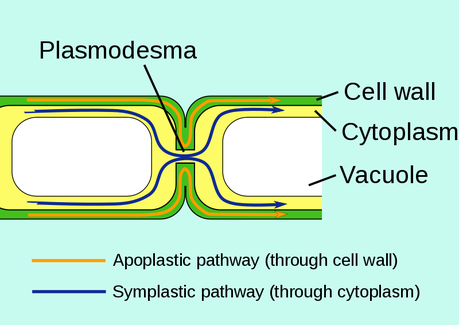In this article, we will discuss about the Difference Between Apoplast And Symplast Pathways. There are two types of transport pathways for the conduction of the water from one region to another. The path followed by the water can be Symplast or Apoplast pathway.
The Symplast is the pathway in which the water molecules move through the plasmodesmata region in the cells. The Symplast is the living region present between two cells that connect one cell with the other.
The Apoplast pathway is the path in which the water is moving between the intercellular spaces. The Apoplast includes the non-living spaces between cells and the cell membrane.
Both pathways are involved in the movement of water across the root. Water flows via the Apoplast in the cortex. It enters the Symplast pathway in the endodermis where walls are impervious to the flow of water due to the presence of Casparian strips.
What is ?
Symplast pathway is one of the three main routes of water movement in plants. In the symplast pathway, water moves from cytoplasm to cytoplasm via the plasmodesmata. Therefore, water does not cross the tonoplast or vacuoles of the cells. The water movement via the symplast pathway takes place by osmosis. And, this pathway uses the protoplasm of the cell.

Figure 01: Symplast Pathway
Moreover, this is one of the main pathways by which water and nutrients reach the xylem of the plant from the soil via roots. Water moves freely through this pathway. Also, low molecular weight solutes such as sugars, amino acids, and ions move between cells.
What You Need To Know About Symplast
- Symplast refers to the continuous arrangement of protoplasts of a plant, which are interconnected by plasmodesmata.
- Symplast consists of protoplasts.
- Symplast is composed of living parts of a plant.
- In Symplast, the water movement occurs by osmosis.
- In Symplast, the water movement is slower.
- The metabolic rate of the cells in the root cortex highly affects the water movement.
- It shows some little resistance to the water movement.
- Beyond the cortex, water moves through the Symplast.
- It is aided by streaming movements of cytoplasm.
What is Apoplast?
The absorption of water by the roots of the plants takes place in two ways:
- Active absorption
- Passive absorption
Inactive absorption, the water first enters the cell sap and passes from one cell to another. This type of movement where protoplasm is involved is called symplast.
In passive absorption, water moves through the apoplast of the root. The apoplast path includes cell walls and intercellular spaces.
The apoplast is the space outside the plasma membrane consisting of intercellular spaces where the material diffuses freely. It does not involve protoplasm in the plant tissues but involves the non-living parts of the plant such as cell wall and intercellular spaces.
Apoplast Pathway
In the apoplast pathway, water is transported from root hair to xylem through the cell wall of intervening cells. The apoplastic route is blocked by a Casparian strip of endodermal cells. Hence, the symplastic route is utilized to deliver water and ions over the cortex. Since the apoplast is made up of non-living components, the apoplastic route is least affected by the metabolic state of the root.
Apoplast and Symplast
Apoplast and symplast are two separate pathways in plants that initiate the passage of water along with ions from root hair via the root cortex to xylem elements. These routes may exist either simultaneously or separately having different rates.
Let us have a detailed look at the apoplast and symplast and the difference between the two.
Difference Between Apoplast And Symplast Pathways In Tabular Form
BASIS OF COMPARISON APOPLAST SYMPLAST
Description Apoplast refers to the nonprotoplasmic components of a plant including the cell wall and the intracellular spaces. Symplast refers to the continuous arrangement of protoplasts of a plant, which are interconnected by plasmodesmata.
Contents Apoplast consists of nonprotoplasmic parts such as cell wall and intracellular space. Symplast consists of protoplast.
Composition Apoplast is composed of non-living parts of a plant. Symplast is composed of living parts of a plant.
Water Movement In Apoplast, the water movement occurs by passive diffusion. In Symplast, the water movement occurs by osmosis.
Speed Of Water Movement In Apoplast, the water movement is rapid. In Symplast, the water movement is slower.
Metabolic Rate The metabolic rate of the cells in the root cortex does not affect the water movement. The metabolic rate of the cells in the root cortex highly affects the water movement.
Resistance To Water Movement It shows less resistant to the water movement. It shows some little resistance to the water movement.
Water Channel With the secondary growth of the root, most of the water moves by the Apoplast route. Beyond the cortex, water moves through the Symplast.
Cytoplasmic Streaming It is not aided by streaming movement of cytoplasm. It is aided by streaming movements of cytoplasm.
Similarities Between Apoplast And Symplast
- Apoplast and Symplast are two ways in which the water moves from root hair cells to the xylem.
- Both the Apoplast and Symplast occur in the root cortex.
- Both the Apoplast and Symplast carry water and nutrients towards the xylem.
Frequently Asked Questions
What do you mean by the apoplast pathway?
In the apoplast pathway, the water moves through the adjacent wall of the epidermis and cortex without entering the cytoplasm.
What is an apoplast?
The apoplast is the system of adjacent, continuous cell walls. It refers to the space outside the plasma membrane within which the molecules can freely diffuse.
Is apoplast active or passive absorption?
The apoplast is the passive absorption that takes place through the apoplast of the root that comprises cell walls and intercellular spaces.
What is the importance of the Casparian strip?
The Casparian strip is a band of waterproof tissue found on the sidewalls of the endodermis of roots. The strip prevents water from entering the pericycle that is important in inducing root pressure.
Top 10 Biotechnology Discoveries
Top 15 Famous Marine Biologists-Biology History
Reference:
1. “Movement Of Water In Roots: 3 Pathways (With Diagram)”. Biology Discussion, 2020, Available here.
2. “Symplast Pathway”. Embibe.Com, 2020, Available here.
3. Apoplast pathway. Available Here
Image Courtesy:
1. “Apoplast and symplast pathways” By Jackacon, vectorised by Smartse – Apoplast and symplast pathways.gif, (Public Domain) via Commons Wikimedia

